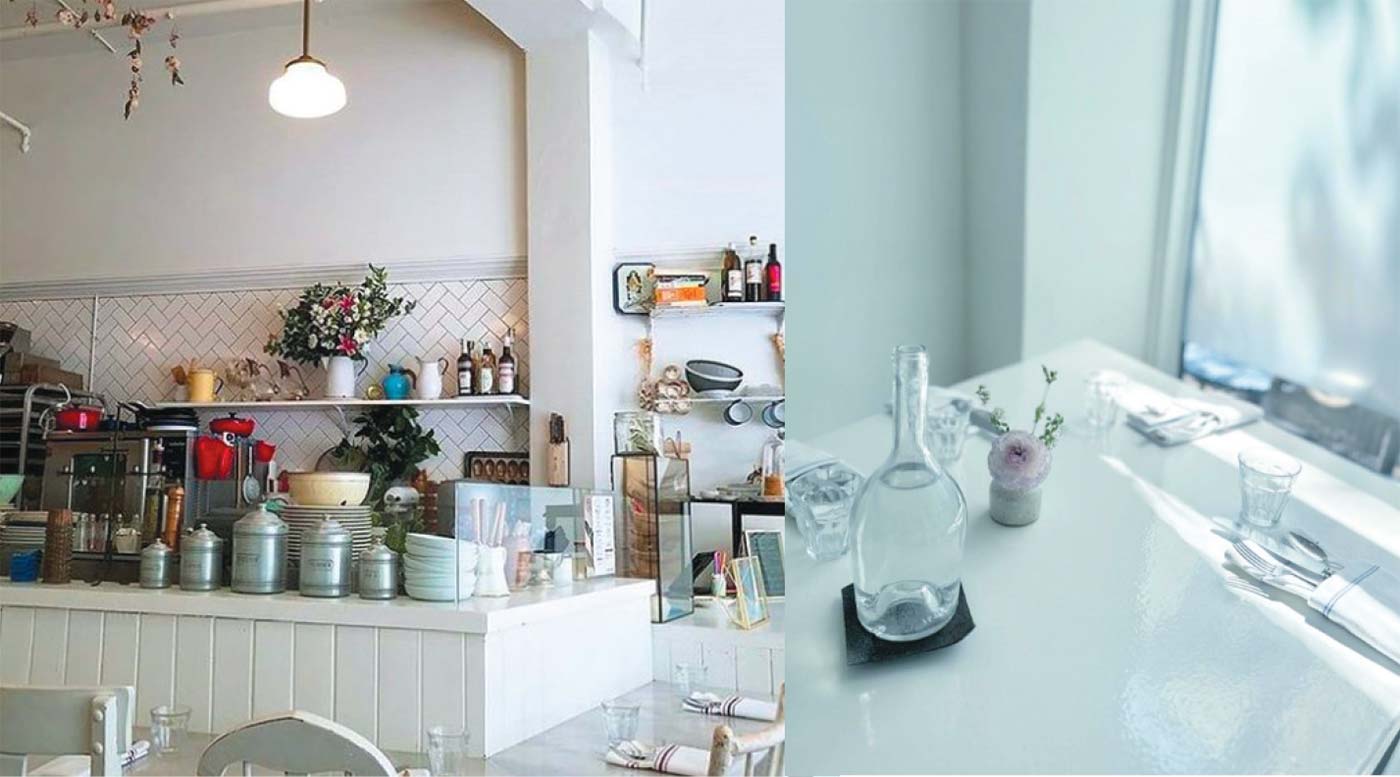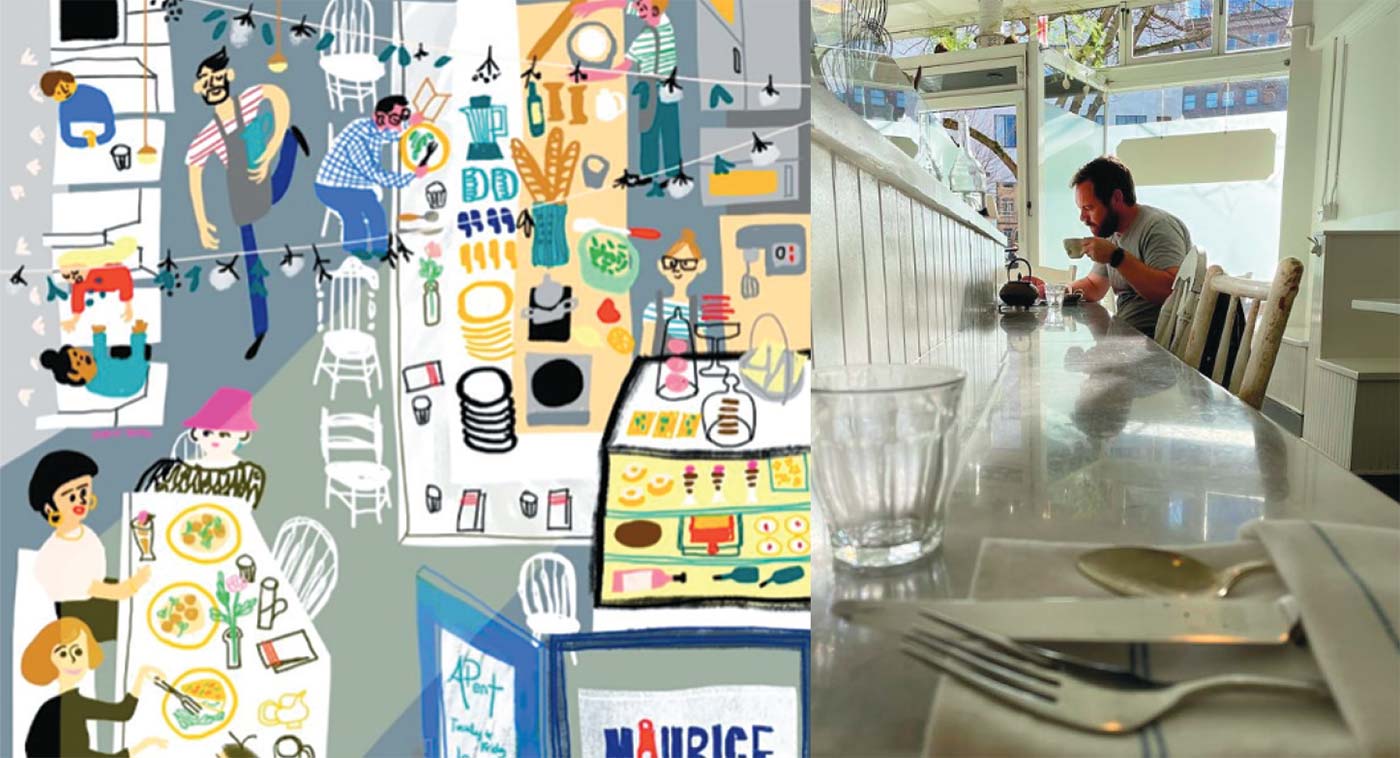
A small sign is hanging outside 921 SW Oak Street in downtown Portland, Oregon: in red, the Swedish letter Å. It marks the door to Måurice, Kristen Murray’s French-Norwegian pastry luncheonette. Just inside stands a gleaming pastry case stocked with fika: cakes and other sweets for the traditional Scandinavian coffee break taken to reconnect and enjoy a moment’s respite.
There are currant-studded rosemary scones, Meyer lemon soufflé pudding cakes in white cups, slices of birdseed honey coconut teacake separated by squares of parchment and individual black pepper cheesecakes. There are neat towers of Nana’s butter cookies and double chocolate Korovas, each under a narrow glass cloche. A lower shelf holds half a pan of the daily quiche scattered with herbs, the silky custard visible within. Bottles of wine fill the bottom of the case, along with several attractive cheeses.
Almost everything in the tiny restaurant is painted bright white, and garlands of dried flowers crisscross the high ceiling. Along one wall are white wooden booths, each adorned with a metal rabbit’s head with coat-hook ears, an homage to the original Maurice, Murray’s pet bunny. An Italian marble pastry counter set with mismatched vintage chairs runs the length of the narrow kitchen. On sunny afternoons, the frosted glass front windows reflect the shadows of branches from the tree-lined sidewalk.
The lunch menu, primarily French, tends to be light enough to leave room for a yummy dessert. On a visit this past winter, I ate chicken liver pâté on brioche with sweet-spicy Medlar jelly redolent of cider, a plate of brilliant pink radishes with good French butter and flaky salt, and a slice of Murray’s delicate, custardy quiche. “It’s meant to be more of a natural feel-good way of eating and treating yourself.” Says Murray, “There’s a little bit of richness and decadence, but it’s not going to wobble you over the head and put you out for the day.”
Writing in 2017, legendary food critic Ruth Reichl called Måurice “the quintessential Portland restaurant… Quirky, passionate, and personal.” I remember this when I sat down to chat with Murray at a small sidewalk table outside the restaurant just before she closed for the day. I’m curious about how things have changed in the decade since she opened Måurice, so I ask her about two other facets that define a quintessential Portland restaurant: a strong sense of community and a deep connection to local farms. “[The farmers] are the only reason I get to do what I do, really,” says Murray, rising briefly to fix the angle of the big umbrella shading the table. “I let them lead, and how things are tasting helps me know what the heck to do with everything… if you want to eat it raw or cooked or salted or pickled or super fresh.”
Since opening Måurice in late 2013, she has worked with many of the same farmers and purveyors. “We’ve always used Chris’s lettuces from Latitude 45 Farm. They’re just so beautiful and delicate. We’ve been pretty committed to Lili at Flying Coyote Farm. We use her chicken livers and chicken for the poulet en pain – an elegant, pastry-wrapped take on chicken pot pie.
Anne and René were the first farmers I met at Gale’s Meadow Farm while cooking at Kir [Wine Bar]. They’re pretty much retired. Their kids have taken over the farm, mainly doing farmers’ markets. Occasionally, we’ll message René and have him play Spanish guitar here for special occasions. When Mom visited, we would go out, and René would make pancakes. The farmers become family in a lot of ways.
I miss Ayers Creek Farm,” she continues. (In 2022, the Boutards sold their farm and moved to upstate New York.) “Carol and Anthony used to let me go do the pickup myself, so I could just walk around the farm and have reflective time. We still have a small amount of the stuff they grew. It has to be enjoyed and shared—that’s the point—but once it’s gone, that whole special era will be gone. It feels extraordinary that we were able to be part of that.”

Raised in California, Murray began working in restaurants at age fourteen. She moved east in her early 20s, picking up pastry shifts at Grammercy Tavern and later working as a pastry chef at Aquavit. In 2004, she was named “Best Pastry Chef in Boston” by Boston Magazine while working for Barbara Lynch at No. 9. Kirsten moved to Portland in 2008 to be the opening pastry chef for the short-lived Lucier.
She visited Portland to cook the pastry tasting, and while staying downtown, she dined at Clyde Common. That night, she met owner Nate Tilden and Andy Ricker, chef-owner of Pok Pok, next to whom she’d been seated. Having barely arrived in town, she had already met two of the biggest names in the local restaurant scene. “Portland felt very welcoming,” she says. “and open. Even though the fact that I was relocating here for a project that I did not necessarily want.” (She was mortified to hear glossy, big-budget Lucier referred to as “Lucifer.”)

When Lucier shuttered after seven months, Murray decided to open her own shop. Backed by investors, she began looking at spaces, picking up odd jobs as she waited to open. At Cacao, she made chocolates and sold cookies she brought in on the back of her bike; the owners, hoping to help her fi nd her footing, introduced her to Kir Wine Bar. The cook was pregnant, so Murray started covering her shifts.
After happening into Steve Jones’s cheese shop, Steve’s Cheese, Jones began taking her on deliveries, which led to a job at DOC. Murray muses, “It just kind of is that chain that links and continues.” Even so, Murray struggled to find work as a pastry chef in a town where chefs had traditionally made their own desserts. “I had many chefs laugh me off when I went to their door,” she says. “I was overqualifi ed, and no one would hire me.”
But after a stint at Paley’s Place, she finally found a suitable space to open Måurice, formerly home to the small press bookshop Reading Frenzy. She ran a successful Kickstarter, raising over $40,000. Clear on her intention to create something lasting, she asked for a 30-year lease. “They told me they just don’t do that,” she says. Måurice opened to acclaim, landing the #9 spot on Bon Appetit’s “Hot 10” national list of best new restaurants in 2014. One of her Kickstarter updates from that year reads, “…remember ‘my thirty-year lease request’? I act as though we have one. We are not going anywhere anytime soon.”
Ten-and-a-half years later, much of her original staff has left the industry or left town. Every single Portland restaurant mentioned above has closed. Tourism has not returned to pre-pandemic levels, and fewer workers are in the neighborhood. As for being located downtown, Murray says, ”It’s complex. Every day is different.”

In the meantime, Måurice has endured as a small sanctuary in times of chaos and peace. “This spot has mattered to me immensely. Over the years, there have been wine-and-laughterfi lled lunches with friends, tea and cake with my daughter, and scones sold through pandemic-era Plexiglas. The red Å on the hanging sign is a little like a lighthouse, a beacon.” Måurice is also one of the few downtown places open for an authentic, sit-down lunch.
Murray’s business primarily consists of regular customers, and the interactions are still the most rewarding. “People have disclosed births, divorces, love, heartbreak, new jobs, and moving. It is as if they were on a shrink’s couch at the pastry counter. Having that sweet connection is rare in a restaurant setting. I hold those conversations very dear. I am grateful that hasn’t changed from day one.”
Would she have done anything differently if she had it to do all over again? “Nothing,” she says. “I adore that this is exactly what it should be. I have not diverted from that.” The last guests step out of the restaurant and into the sunlight, and Murray interrupts herself to wave and wish one of them a happy birthday.
Måurice, at 921 SW Oak St, is open for lunch and fika Wednesday through Saturday, 11 am-3 pm.

